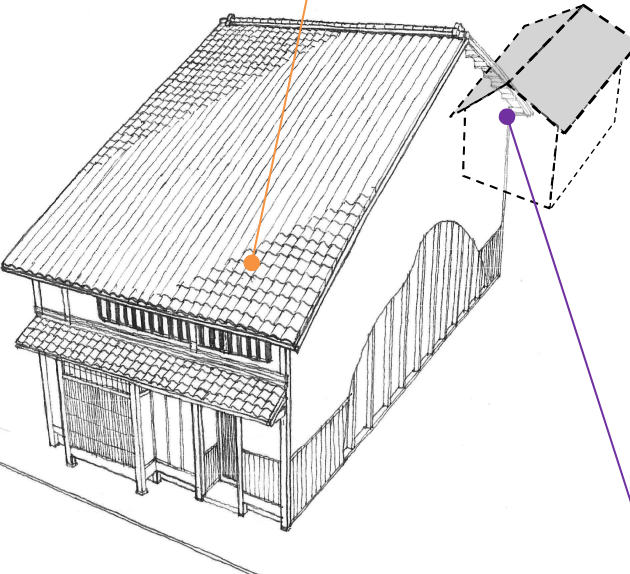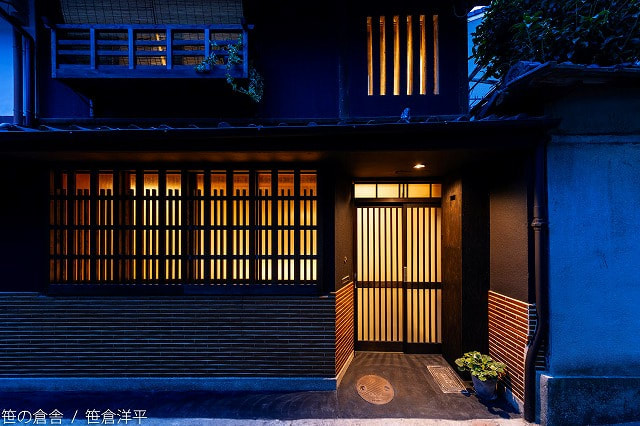Example: an Annex Extension(In the case of an annex extension to a residence with a total floor area of 100㎡ or less and two floors or less in a semi-fire prevention zone) As a general rule, when building an separate annex, it is required to conform to the existing regulations. If it is an extension of an existing building, the collective regulations for the existing part and the individual regulations for structure, fire prevention, and evacuation are also applied retroactively. If a separate annex building is constructed, some of the individual and collective regulations are not applied retroactively to the existing building. For details, please refer to the notes below. Collective Regulations:
Individual Regulations (Existing Buildings) The individual regulations (provisions of Chapter 2 of the Building Standards Law) are not applied retroactively. The part of the building that was legal must remain legal after the expansion. ⇒ The individual regulations are not applied retroactively. Procedural Regulations
Individual Regulations (Separate Building Extensions)
Notes:
Conditions for Separate Annex Buildings (All of the following must be satisfied.) 1. The buildings must be structurally separate. (Each building is independent in terms of structural durability. ) 2. The buildings must be functionally separate. (The annex and the main building are not connected by an indoor space.) 3 The buildings must be separate in appearance. (The exterior of the buildings can be recognized as two buildings by socially accepted standards.) Example: Change of Use(Changing the use of a residential building with two floors or less and a total floor area of less than 200㎡ to an inn) When changing the use of a building, the provisions on building coverage ratio, floor area ratio, and structural durability do not apply, but the restrictions of the zoning district and the provisions on fire prevention and evacuation apply depending on the intended use and scale of the change. When changing the use to a specified building with a total floor area of more than 100 square meters, a building permit application is required. Evacuation Regulations
Procedural Rules
Collective Regulations
Fire Prevention Regulations
Other Laws and Regulations In addition to the Building Standards Law, other laws and regulations such as permits and approvals may be required for changes in use. Major Relevant Regulations (Fire Service Act)
The following may be required depending on the size of the building:
Notes:
The regulations for fire-prevention zones/quasi-fire-prevention zones and structural durability provisions do not apply retroactively, but in order to make buildings safe and secure, you are advised to make the building fireproof and earthquake-proof. Example: Large-Scale Repairs and Remodeling(For residences with a total floor area of 100 ㎡ or less and two floors or less in a quasi-fire zone) The Building Standard Law is applied retroactively to construction work*1 that falls under the category of large-scale repair or remodeling, and in general, the specifications of the renovated house need to conform to the current law. However, there are a number of relaxed regulations that allow for large-scale repairs and remodeling under certain conditions. Fire prevention
 Eaves with wooden panels
* 1: The specifications must conform to the Notification and be approved by the Minister. Procedural Rules
Collective regulations
Structure
*2: Examples of construction work that falls under the category of large-scale repairs or remodeling
Examples of work that is NOT considered large-scale repairs or remodeling
Q: Are extensions and other large-scale construction possible?Even if the building is an existing unqualified building, various regulations apply to extensions, large-scale repairs, large-scale remodeling, and changes in use. While the Building Standard Law is applied retroactively, it is relatively easy to extend, repair, remodel, and change the use of a building under certain conditions. There are also relatively easy methods to build a new Kyo-Machiya house. Large-Scale Repair and Remodeling: Most of the exterior walls are damaged, but is it easy to repair them? Change of Use: I would like to turn my Kyo-Machiya house into a Japanese inn, but is it easy to change the use? Extensions: I would like to build an extension as my house is not spacious enough, but is it easy to do so? New Construction: I would like to build a new house with the design and structure of a traditional wooden Kyo-Machiya, but is it easy to do so? A: Yes, they are possible in certain instances. Large-Scale Repair and Remodeling: ⇒ Can be done easily
The Building Standard Law is applied retroactively, but there are some mitigation clauses. For details, please refer to "Examples of Large-Scale Repairs and Remodeling." Change of Use: ⇒It is easy to change the use.
For details, see "Examples of Change of Use." Extensions: ⇒ An existing building can be easily extended.
For details, please refer to "Examples of Separate Building Extensions." New Construction:
⇒ New construction is possible.
For details, please refer to "Examples of New Construction." Q: Can the Exterior Be Legally Maintained?A: Exterior Maintenance Can Be Done Legally.Building Fixtures: I want to make the fittings of the fire prevention equipment look like wooden fittings. Can this exterior modification be made legally? ⇒ Can be modified legally.
Renovation to windows Machiya-style "Mushiko" windows of can be installed. Fire prevention equipment fittings can be installed on the inside of the ”Mushiko” windows to improve fire safety performance as well as the appearance of the building. Wooden Lattice: I want to install a wooden lattice on the outside of the fittings of the fire prevention equipment. Can this exterior modification be made legally? ⇒ Can be modified legally.
Installation of wooden lattice Wood can be put on the fire prevention equipment of the designated specification.
Wooden lattices can be installed on the outside of fire prevention equipment. However, care must be taken if the room behind does not have windows for daylight and smoke exhaustion. The installation of wood on fire prevention equipment of the designated specifications or the installation of lattices on the outside of fire prevention equipment - including fire prevention equipment approved by the Land, Infrastructure, Transport and Tourism Minister - does not degrade the fire protection performance of the fire prevention equipment, and thus wooden fittings can be installed to improve the exterior appearance. Q: Can the Exterior Be Legally Maintained?A: Exterior Maintenance Can Be Done Legally.Wall: I want to change my mortar walls to mud walls. Can this exterior modification be made legally? ⇒ Can be modified legally.
Eaves: I want to change the mortar-finished eaves to wood-finished eaves. Can this exterior modification be made legally? ⇒ Can be modified legally.
Before the maintenance of the exterior After the maintenance of the exterior The exterior of the building on the street side can be modified without the retroactive application of the Building Standard Law if the area is less than half of the entire exterior wall area. Before the maintenance of the exterior (Mortar exterior wall) After the maintenance of the exterior (Earthen wall) There are specifications for fireproof construction of earthen walls and eaves lining that make use of the design of Kyo-Machiya houses. The earthen walls and eaves lining can be made fireproof by using the specifications designated by the Ministry of Land, Infrastructure, Transport and Tourism or those approved by the Minister of Land, Infrastructure, Transport and Tourism.
Q: Can the Exterior Be Legally Maintained?Research on fire prevention to preserve traditional designs has made it possible to renovate buildings in a way that makes use of traditional designs. This section will introduce the methods used to legally improve the appearance of the building. *If the exterior improvement falls under the category of large-scale repair or large-scale redecoration, renovation work may be required for areas other than the exterior improvement due to the retroactive application of the Building Standards Law. A: Exterior Maintenance Can Be Done Legally.Wall: I want to change my mortar walls to mud walls. Can this exterior modification be made legally? ⇒ Can be modified legally.
For details, please refer to "Exterior Modifications Are within the Legal Framework: Wall & Eaves" Eaves: I want to change the mortar-finished eaves to wood-finished eaves. Can this exterior modification be made legally? ⇒ Can be modified legally.
For details, please refer to "Exterior Modifications Are within the Legal Framework: Wall & Eaves" Building Fixtures: I want to make the fittings of the fire prevention equipment look like wooden fittings. Can this exterior modification be made legally? ⇒ Can be modified legally.
For details, please refer to "Exterior Modifications Are within the Legal Framework: Building Fixtures & Fittings" Wooden Lattice: I want to install a wooden lattice on the outside of the fittings of the fire prevention equipment. Can this exterior modification be made legally? ⇒ Can be modified legally.
For details, please refer to "Exterior Modifications Are within the Legal Framework: Building Fixtures & Fittings" Repairs & Renovation of Kyo-Machiya Houses (Q&A)Pillars &Beams: The pillars around the sink might be decaying. If they are, I want to replace them, but can I legally repair them? ⇒ Can be repaired legally. * Repair of half or less of columns and beams ⇒ The above repair is not subject to retroactive application of the Building Standard Law. After reinforcing the beam Columns and beams can be reinforced within the legal framework. Reinforcing columns and beams with supporting columns and beams is not subject to retroactive application of the Building Standard Law. Before repairing the column After repairing the column Partial repairs of columns and beams can be made within the legal framework. Repairs of less than half of the columns and beams (columns are counted for each floor) is not subject to retroactive application of the Building Standard Law. Note: If major structural components such as columns and beams have deteriorated due to mite damage or decay, repairing these components and making them sound will improve earthquake resistance.
Repairs & Renovation of Kyo-Machiya Houses (Q&A)Stairs: The slope of the stairs is steep and unsafe, so I want to make the slope moderate, but can I do it legally? ⇒ Can be installed legally. * Installation of stairs ⇒ The above modification is not subject to retroactive application of the Building Standard Law. Box stairs or stairs with a steep slope Stairs with a gentle slope that comply with current standards It is desirable to replace stairs with a steep slope in Kyo-Machiya houses with those with a gentle slope to ensure the residents' safety.
In light of the purpose of the Building Standards Law, the replacement of steep stairs that existed prior to the enforcement of the law with those that conform to the current standards (except for cases that fall under the category of expansion) will be treated as an act that is not subject to retroactive application. Repairs & Renovation of Kyo-Machiya Houses (Q&A)⇒ Can be repaired legally. * Repainting of rough walls * Repairs to the substrate (Komai bamboo) (less than half of the wall area) ⇒ The above repairs are not subject to retroactive application of the Building Standard Law. Before repairing the wall During the repair of the wall The repair (restoration) of earth plaster walls does not constitute a large-scale repair and is not subject to retroactive application of the Building Standard Law.
Note: Fire safety can be improved by making use of the design of the Kyo-Machiya to create a fire-resistant exterior wall.
|
Details
AuthorArrows International Realty Corp. Archives
June 2023
Categories
All
|
































 RSS Feed
RSS Feed